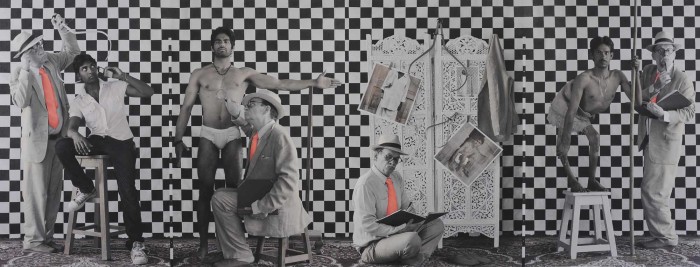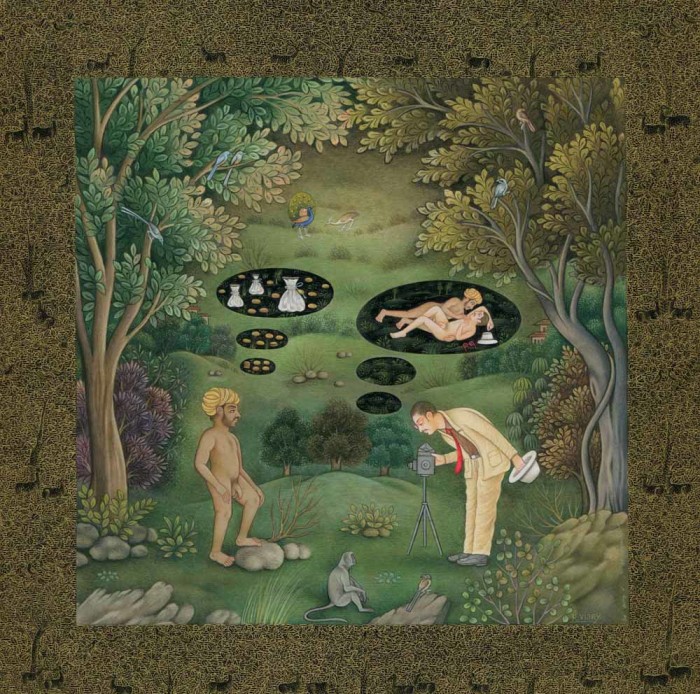Waswo X. Waswo has enjoyed an interesting life. He is a painter, poet and a photographer.
Being a foreigner, he is often accused of portraying a negativity about India. But his works highlight his own experiences of places, people and culture, providing an empathetic view of “India”.
He works with local people – barbers, chaiwallas, shopkeepers and has collaborated with local artists R. Vijay and Rajesh Soni (whose grandather Prabhu Lal Verma-Soni had been a court photographer and hand colourist to the Maharana Bhupal Singh of Mewar) for his works. His friends affectionately call him Cha Cha.
The OpenHaus team spoke to him at the opening of his latest show “Confessions of an Evil Orientalist” where along with displaying his works, he invited the subjects of his work for the show- a rarity in the Indian art scenario.

How would you describe Waswo the individual in few words?
“Multifaceted” is the first word that comes to mind. I have a lot of sides. I’m sensitive, but I know at times I can also be unfeeling. I can be generous but I can also be demanding. People who know me learn that I have short-lived explosions of anger. But all in all I would hope I am a good mix of logic, empathy, and hard work.
You have been in India for 10 years now, how has India influenced your work?
It is impossible to overstate the influence of India, not only in my work, but in me as a person. Where do I start? For one, in India I learned to love the rural environment and the small town or village. Before coming here I was very much an urbanite who loved the big cities of America and Europe. India forced me to redefine notions I had about personal space, privacy, family bonds, material comforts, and (I know it is the ultimate firangi cliché) in India I discovered some sides to spirituality I hadn’t previously known. All of these changes came to play in my art. And of course the awareness of outsider/insider alien-to-the-culture issues that became integral to the miniature work especially.
Your style of art is massively absorbed into long out of fashion style of pictorial photography. Any particular reason for opting it as a genre?
A lot of contemporary photographic art seems to dwell in the “snapshotaesthetic” that places very little emphasis on composition. The concerns are conceptual and these images are analysed through a conceptual prism. I find nothing wrong with that, but to be honest I feel this cold, “snapshot” style is what has become out of date. It has been done to death. Pictorialism placed heavy emphasis on composition, light and shade. The Pictorialists were unashamed in taking inspiration and guidance from traditional painting. Fashions in photography and the arts come and go and I don’t pay much attention to them. It’s just that I found in Pictorialism a genre that to me fell out of fashion before it was fully explored. I like going back to it and using its style as a new starting point for exploration.

Your current show – “Confessions of an Evil Orientalist” has received interesting reviews. How did you go about conceptualizing the show/artworks?
I had been working on the Second Incarnation part of the New Mythsseries. These are the “Hanuman” images where a muscular model named Aslam Mohammed poses as a god-man-beast with long langur-like tail. While working on this series I again realized that there would be criticisms levelled at the work for its obvious Orientalist feel, and one day I just got very self-reflective and sat down to make a list of those things I was guilty of as a foreign artist living and working in India. The list was a very sincere writing out of confessions, and soon I noticed a couple of things. One was that each confession began with the words “I have” which certainly was an indication of privilege as in “haves and have-nots”. The other thing I noticed was that much of what I was confessing many Indians, especially middle-class and wealthy Indians, were probably equally guilty of. At some point in the writing the whole list transformed into a sort of mantra. I realized it had become a poem. And in it were many things that people from all cultures could reflect upon. It was then that I went back and re-looked at what I had produced in the Second Incarnation images and realized that in some strange way they fit this theme. They are images of the aggressive, dominating side of the masculine ego, which I think is very integral to the workings of Orientalism, hegemony, and “Othering” in general. The concept of the show started there, and with that we produced other works that fit the theme.
How did you go about choosing Indian artists R Vijay and Rajesh Soni and other local talents for your artworks. How has been your experience working with them?
The first Indian artist I collaborated with was R. Vijay, who I met inUdaipur. He was, and still is, a very shy painter. He was producing images of birds for the tourist trade when we met, but he obviously longed to do more with his art. Strangely, Rajesh Soni entered the picture as primarily a translator working between me and Rakesh. When I first met Vijay his English was pretty minimal. One day, as Rajesh was helping explain a painting idea of mine to Rakesh, he noticed the black and white digital test prints I was then making with an Epson 2400 at my Udaipur studio. He said, “Cha Cha! I can paint these!”. Rajesh’s grandfather, Prabhu Lal Verma (Soni) had been a court photographer and hand-colourist to the Maharana Bhupal Singh of Mewar. And that was the beginning of a collaboration that has lasted till this day. Rajesh is the exact opposite of Rakesh…not shy at all, very talkative and completely outgoing. Somehow the three of us create a good chemistry. I sometimes compare Rajesh and Rakesh and myself to a rock band. In fact, I often refer to us as “the rock band” in private. We have that kind of tight and intense work relationship.
What aspect of culture attracts you?
Culture is a very encompassing word. I really love all things cultural…from pop music to tribal arts to ballet and opera. But basically I am a visual person, and my strongest attraction is most always toward something I find visually stimulating, or extremely new, or beautifully and frailly old. I can appreciate everything from the conceptual to the abstract, but I’ll admit I am still a real sucker for beauty. I believe in beauty…the beauty of the unspoilt environment, the beauty of humanity.
An artist is the most vulnerable individual to critics, how do you react when at exhibitions people label your observation, study and work as a foreigner’s judgement upon a land and its people?
When I am accused of making a negative judgement upon India throughmy work I can react with anything from disbelieving amusement to self-righteous anger. That all depends on my mood of course. The people I photograph… i.e. the chai-wallahs, barbers, small town shopkeepers, farmers, the sort of common folks who populate my photographs…they are ninety-nine percent of the time so happy with what we create. They enjoy participating in the photo’s creation, they add to it, and they smile and nod with approval at the finished result. Oftentimes the word they use after a shoot is that the scene we have created is “real”. And then someone in one of the large metros comes along and tells me that I am exploiting these people or that I am perpetuating clichés about India. It’s hard not to take some of this criticism as an insult to the people I photograph. Why are some people so obviously embarrassed by the rural and traditional that is very much a part of India’s culture? That is something I find very hard to understand.
Your journey looks colourful but hectic, did you ever feel like giving up, how did you fight the feeling?
In general I feel extremely lucky to have spent so much time here, seen somany things and accomplished so much in terms of my art. Of course there are times I have felt like giving up. Not just due to the problems of being a foreigner living in India, but due to the problems of being an artist in general.
Any word of advice for aspiring artists?
I would say that if anyone aspires to be an artist because they think it is an easy life, then they have a totally wrong idea. Being an artist is hard, both in terms of the work involved, and also in terms of the emotional investment and/or lack of appreciation. A successful artist is basically self-employed, and you need to develop a strong discipline and work ethic. If you want to be an artist simply because you have fun painting, then perhaps you should think of being a “Sunday painter” but support yourself through another means, maybe by going into crafts. To survive as a pure artist is extremely difficult. As a contemporary artist you are basically saying to the world “What I think and create is important enough that the world should pay me to do exactly what I want to do”. That is a very hard concept to sell. You have to believe it yourself. You have to know in your heart that what you are saying through your art is worth the world’s attention.